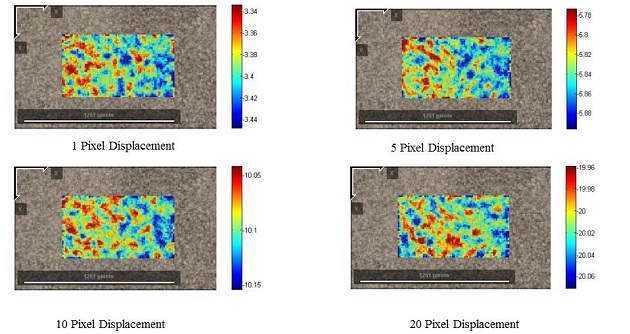Digital Image Correlation
Main Content

Digital Image Correlation (DIC) is an optical experimental technique that employs tracking and image registration techniques for accurate two-dimensional (2D) and three-dimensional (3D) measurements of small changes in the images. It is a technique based on surface analysis methods. These methods involve monitoring and identifying changes in a pattern applied to the surface of objects under observation, which have been subjected to some form of mechanical pressure or strain. DIC of speckle patterns has been used extensively in many applications to measure displacement components and deformation gradients of an object’s surface due to deformation for over four decades. This technique was pioneered by Dr. Chu et al. in the early 1980s for measuring surface displacements and deformation. A faster approach for image correlation was later developed by Sutton, et al. Instead of using the iterative approach, such as a coarse-fine method, a second order Newton-Raphson method was employed. This method improved the computation speed of the correlation. However, it presented some convergence difficulties. A special technique was then added to achieve a higher probability of convergence. Methods to determine the three-dimensional (3D) displacement have also been developed by combining digital image correlation, speckle metrology, and photogrammic or stereoscopic principles. These methods involve two cameras separated by a predetermined distance. The lines of sight from two cameras may either be parallel to each other or form a pan angle between them. As soon as two image points are matched by correlation methods, the three-dimensional coordinates of the physical point may be determined. A surface contour may be generated from one pair of stereo images, while deformation measurement requires the correlation of four images: a stereo pair before deformation and another after deformation.
DIC is now a proven technique both in terms of the technical development and in terms of the applications for which it is applied. The development and broad applications of this method can be attributed to the rapid evolution of computing power, CCD camera or recorders, and frame grabbers. Today, the uses of multiple cameras permit us to perform the measurement of three- dimensional (3D) shapes as well as the measurement of the 3D deformation. 3D DIC (DIC-3D) is now being used for a wide range of applications on both large and small structures. Overall, DIC technique is now progressing very quickly both in terms of the technical development and in terms of the applications for which it is applied.
DIC is now a proven technique both in terms of the technical development and in terms of the applications for which it is applied. The development and broad applications of this method can be attributed to the rapid evolution of computing power, CCD camera or recorders, and frame grabbers. Today, the uses of multiple cameras permit us to perform the measurement of three- dimensional (3D) shapes as well as the measurement of the 3D deformation. 3D DIC (DIC-3D) is now being used for a wide range of applications on both large and small structures. Overall, DIC technique is now progressing very quickly both in terms of the technical development and in terms of the applications for which it is applied.



